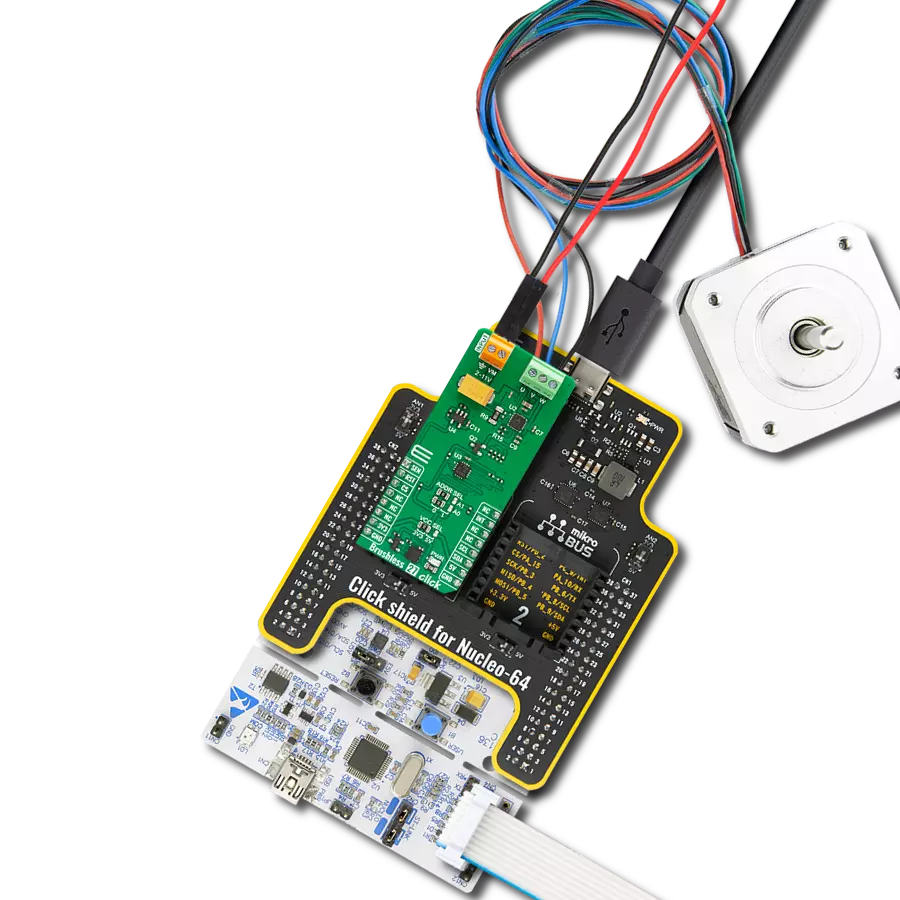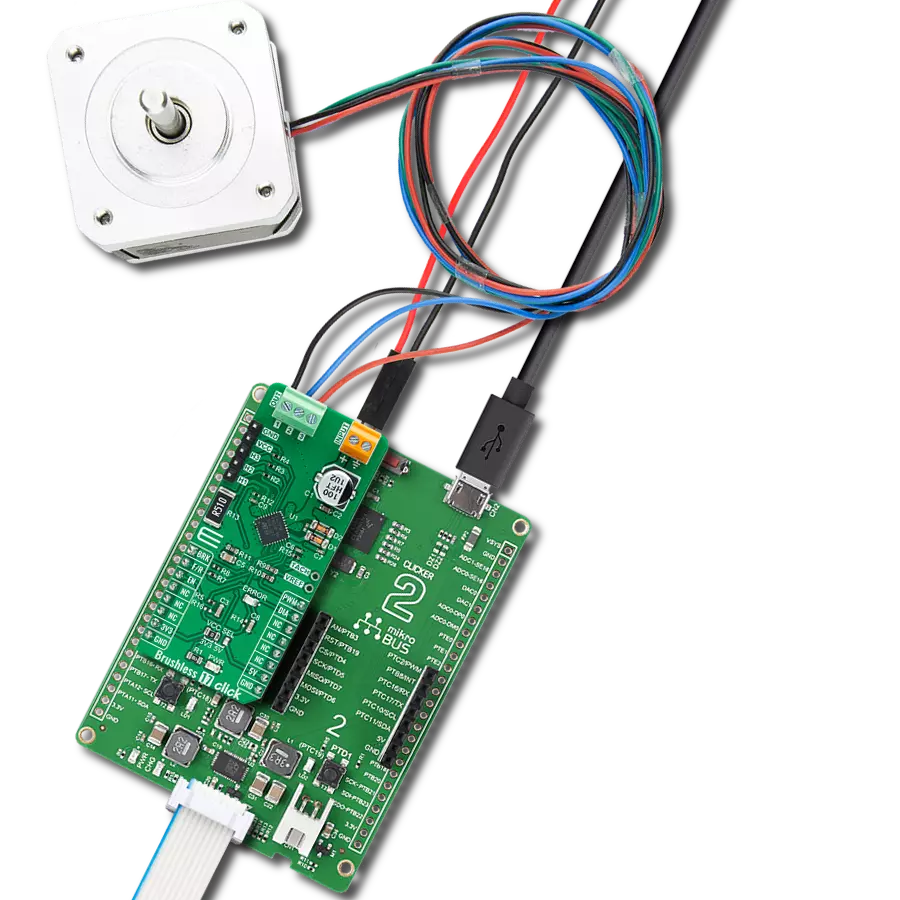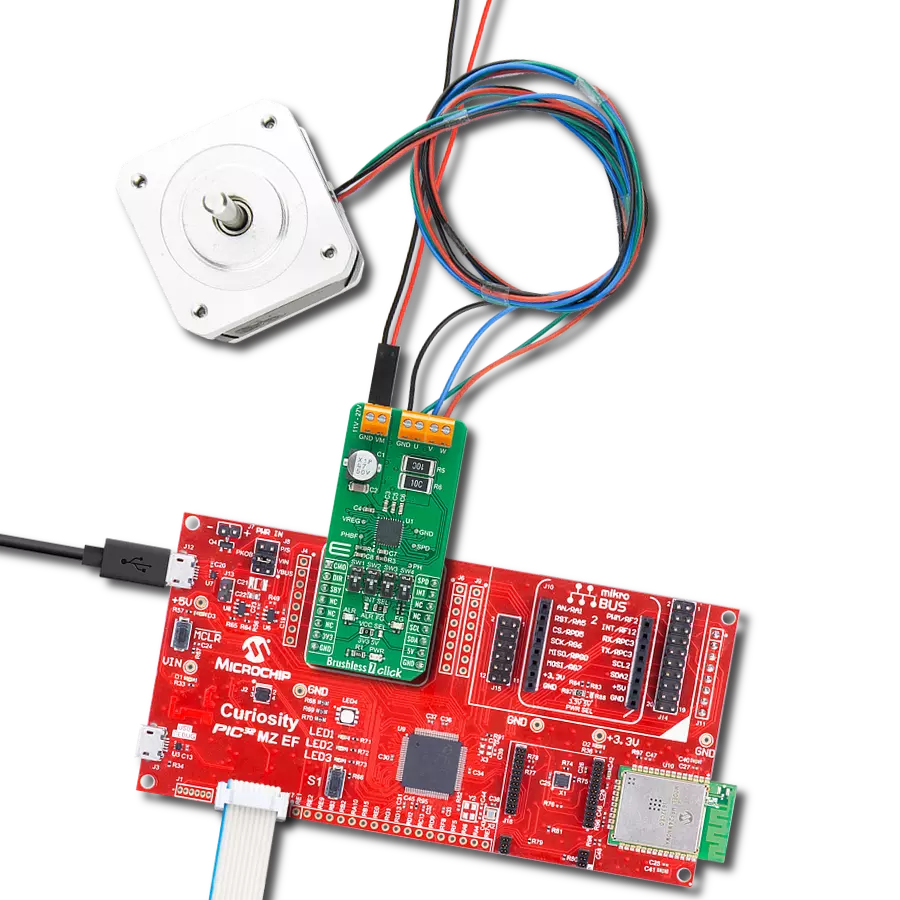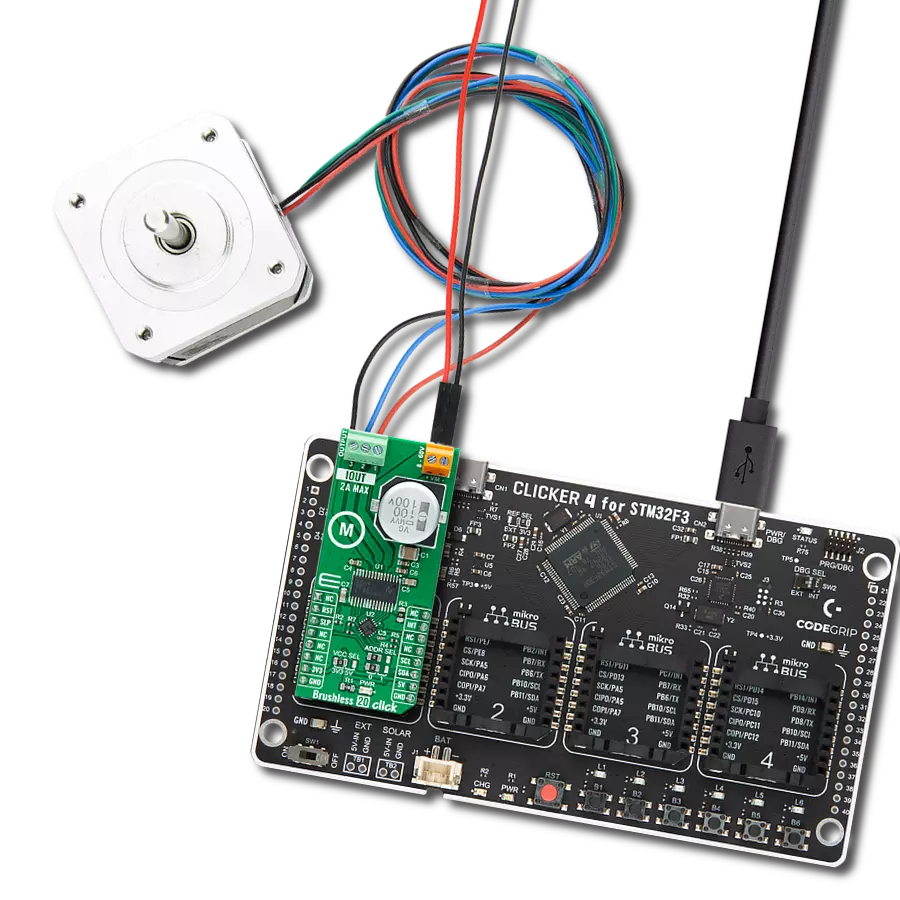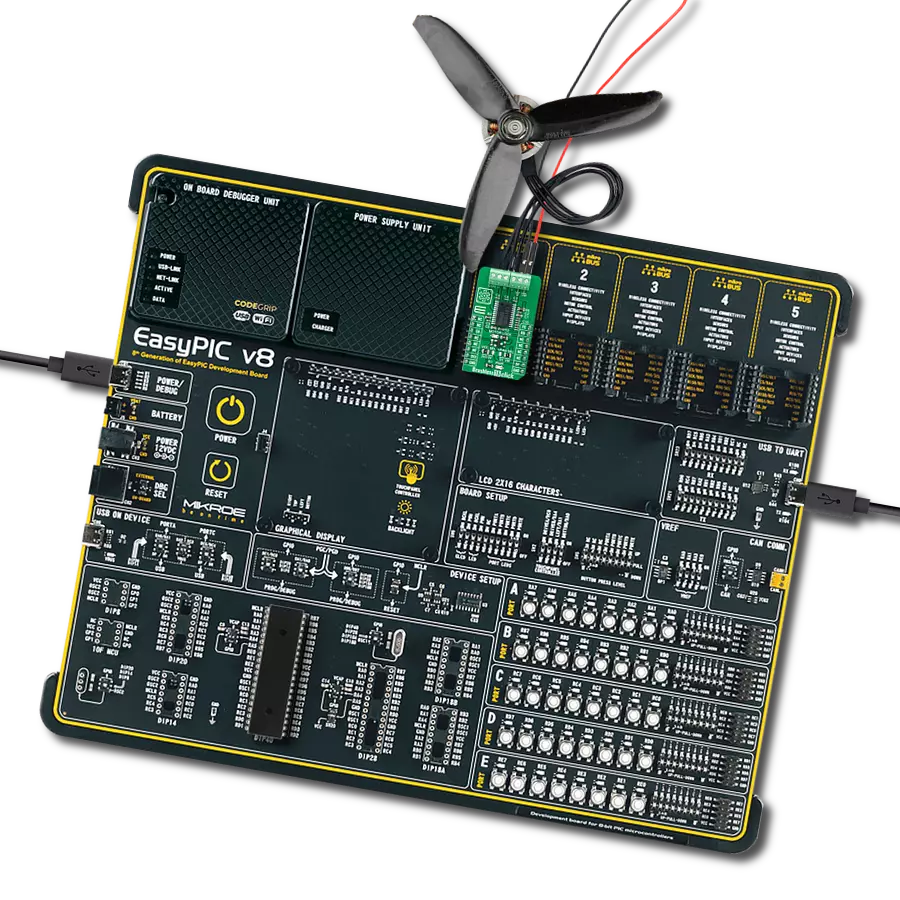Don't let your motors be limited. Take action and integrate advanced brushless motor control for limitless possibilities
A
A
Hardware Overview
How does it work?
Brushless 12 Click is based on the L6235, a fully integrated motor driver specifically developed to drive a wide range of BLDC motors with Hall effect sensors from STMicroelectronics. The L6235 includes a 3-phase DMOS bridge, an OFF-TIME PWM current controller, the decoding logic for single-ended Hall sensors that generate the required power stage sequence, and other features for safe operation and flexibility. It also has a built-in Over Current Detection (OCD) that allows protection against short circuits between the outputs and between output and ground. Integrated decoding logic of the L6235 provides the correct sequence on the three outputs labeled as U V W for motors with 60° and 120° spaced Hall effect sensor signals. The sensor outputs are connected to the device's H1, H2, and H3 inputs through the HALL header. H1 input of the L6235 is internally connected to a monostable that provides a width pulse on the TACHO output. With a pull-up resistor on this output, the resulting
waveform at the pin will be a square wave whose frequency is proportional to the motor rotation speed, with an on-time set by the potentiometer VR1 labeled as TACHO. An additional potentiometer on this Click board™ VR2, labeled OFF-TIME, can be used for a PWM current regulation capacity. VR1 potentiometer defines the on-time integration and is compared to a voltage proportional to the desired speed by the Op-Amp LM358 from STMicroelectronics. The output of the Op-Amp represents the speed error signal. Providing this signal to the VREF input of the L6235, which sets the current in the motor windings, the speed error will act on the motor modifying its torque to maintain the speed at a constant value. This feature of the L6235 can be selected by the switch labeled as VREF, which allows the selection between Torque or Speed Mode. Brushless 12 Click communicates with MCU using several GPIO pins. The RST pin of the mikroBUS™ socket labeled EN represents the
Enable function and serves as Chip Enable that turns OFF all power MOSFETs of the L6235. CS pin labeled BRK switches ON all high-side power MOSFETs and allows the user to use the brake function. And the last GPIO pin routed to the PWM pin of the mikroBUS™ socket labeled as F/R selects the direction of the motor rotation. It also possesses two connectors, where one of them represents an external power supply labeled as VIN in the range from 8 to 48V maximum, and the next one labeled with U V W is a terminal on which the BLDC motor needs to be connected. This Click board™ can be operated only with a 5V logic voltage level. The board must perform appropriate logic voltage level conversion before using MCUs with different logic levels. It comes equipped with a library containing functions and an example code that can be used, as a reference, for further development.
Features overview
Development board
Nucleo-64 with STM32F410RB MCU offers a cost-effective and adaptable platform for developers to explore new ideas and prototype their designs. This board harnesses the versatility of the STM32 microcontroller, enabling users to select the optimal balance of performance and power consumption for their projects. It accommodates the STM32 microcontroller in the LQFP64 package and includes essential components such as a user LED, which doubles as an ARDUINO® signal, alongside user and reset push-buttons, and a 32.768kHz crystal oscillator for precise timing operations. Designed with expansion and flexibility in mind, the Nucleo-64 board features an ARDUINO® Uno V3 expansion connector and ST morpho extension pin
headers, granting complete access to the STM32's I/Os for comprehensive project integration. Power supply options are adaptable, supporting ST-LINK USB VBUS or external power sources, ensuring adaptability in various development environments. The board also has an on-board ST-LINK debugger/programmer with USB re-enumeration capability, simplifying the programming and debugging process. Moreover, the board is designed to simplify advanced development with its external SMPS for efficient Vcore logic supply, support for USB Device full speed or USB SNK/UFP full speed, and built-in cryptographic features, enhancing both the power efficiency and security of projects. Additional connectivity is
provided through dedicated connectors for external SMPS experimentation, a USB connector for the ST-LINK, and a MIPI® debug connector, expanding the possibilities for hardware interfacing and experimentation. Developers will find extensive support through comprehensive free software libraries and examples, courtesy of the STM32Cube MCU Package. This, combined with compatibility with a wide array of Integrated Development Environments (IDEs), including IAR Embedded Workbench®, MDK-ARM, and STM32CubeIDE, ensures a smooth and efficient development experience, allowing users to fully leverage the capabilities of the Nucleo-64 board in their projects.
Microcontroller Overview
MCU Card / MCU
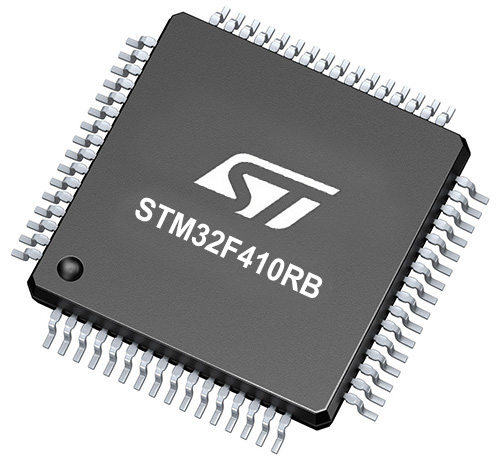
Architecture
ARM Cortex-M4
MCU Memory (KB)
128
Silicon Vendor
STMicroelectronics
Pin count
64
RAM (Bytes)
32768
You complete me!
Accessories
Click Shield for Nucleo-64 comes equipped with two proprietary mikroBUS™ sockets, allowing all the Click board™ devices to be interfaced with the STM32 Nucleo-64 board with no effort. This way, Mikroe allows its users to add any functionality from our ever-growing range of Click boards™, such as WiFi, GSM, GPS, Bluetooth, ZigBee, environmental sensors, LEDs, speech recognition, motor control, movement sensors, and many more. More than 1537 Click boards™, which can be stacked and integrated, are at your disposal. The STM32 Nucleo-64 boards are based on the microcontrollers in 64-pin packages, a 32-bit MCU with an ARM Cortex M4 processor operating at 84MHz, 512Kb Flash, and 96KB SRAM, divided into two regions where the top section represents the ST-Link/V2 debugger and programmer while the bottom section of the board is an actual development board. These boards are controlled and powered conveniently through a USB connection to program and efficiently debug the Nucleo-64 board out of the box, with an additional USB cable connected to the USB mini port on the board. Most of the STM32 microcontroller pins are brought to the IO pins on the left and right edge of the board, which are then connected to two existing mikroBUS™ sockets. This Click Shield also has several switches that perform functions such as selecting the logic levels of analog signals on mikroBUS™ sockets and selecting logic voltage levels of the mikroBUS™ sockets themselves. Besides, the user is offered the possibility of using any Click board™ with the help of existing bidirectional level-shifting voltage translators, regardless of whether the Click board™ operates at a 3.3V or 5V logic voltage level. Once you connect the STM32 Nucleo-64 board with our Click Shield for Nucleo-64, you can access hundreds of Click boards™, working with 3.3V or 5V logic voltage levels.
Brushless DC (BLDC) Motor with a Hall sensor represents a high-performance motor from the 42BLF motor series. This motor, wired in a star configuration, boasts a Hall Effect angle of 120°, ensuring precise and reliable performance. With a compact motor length of 47mm and a lightweight design tipping the scales at just 0.29kg, this BLDC motor is engineered to meet your needs. Operating flawlessly at a voltage rating of 24VDC and a speed range of 4000 ± 10% RPM, this motor offers consistent and dependable power. It excels in a normal operational temperature range from -20 to +50°C, maintaining efficiency with a rated current of 1.9A. Also, this product seamlessly integrates with all Brushless Click boards™ and those that require BLDC motors with Hall sensors.
Used MCU Pins
mikroBUS™ mapper
Take a closer look
Click board™ Schematic

Step by step
Project assembly
Software Support
Library Description
This library contains API for Brushless 12 Click driver.
Key functions:
brushless12_set_brake- This function sets the BRK pin to the desired statebrushless12_set_direction- This function sets the F/R pin to the desired statebrushless12_set_enable- This function sets the EN pin to the desired state
Open Source
Code example
The complete application code and a ready-to-use project are available through the NECTO Studio Package Manager for direct installation in the NECTO Studio. The application code can also be found on the MIKROE GitHub account.
/*!
* @file main.c
* @brief Brushless 12 Click Example.
*
* # Description
* This example demonstrates the use of Brushless 12 Click board.
*
* The demo application is composed of two sections :
*
* ## Application Init
* Initializes the driver and sets the Click default configuration.
*
* ## Application Task
* Drives the motor in the forward direction for 5 seconds, then pulls brake for 2 seconds,
* and after that drives it in the reverse direction for 5 seconds, and pulls brake for 2 seconds.
* Each step will be logged on the USB UART where you can track the program flow.
*
* @author Stefan Filipovic
*
*/
#include "board.h"
#include "log.h"
#include "brushless12.h"
static brushless12_t brushless12; /**< Brushless 12 Click driver object. */
static log_t logger; /**< Logger object. */
void application_init ( void )
{
log_cfg_t log_cfg; /**< Logger config object. */
brushless12_cfg_t brushless12_cfg; /**< Click config object. */
/**
* Logger initialization.
* Default baud rate: 115200
* Default log level: LOG_LEVEL_DEBUG
* @note If USB_UART_RX and USB_UART_TX
* are defined as HAL_PIN_NC, you will
* need to define them manually for log to work.
* See @b LOG_MAP_USB_UART macro definition for detailed explanation.
*/
LOG_MAP_USB_UART( log_cfg );
log_init( &logger, &log_cfg );
log_info( &logger, " Application Init " );
// Click initialization.
brushless12_cfg_setup( &brushless12_cfg );
BRUSHLESS12_MAP_MIKROBUS( brushless12_cfg, MIKROBUS_1 );
if ( brushless12_init( &brushless12, &brushless12_cfg ) == DIGITAL_OUT_UNSUPPORTED_PIN )
{
log_error( &logger, " Application Init Error. " );
log_info( &logger, " Please, run program again... " );
for ( ; ; );
}
brushless12_default_cfg( &brushless12 );
Delay_ms ( 100 );
log_info( &logger, " Application Task " );
}
void application_task ( void )
{
log_printf( &logger, "The motor turns forward! \r\n" );
brushless12_set_direction ( &brushless12, BRUSHLESS12_DIR_FORWARD );
brushless12_set_brake ( &brushless12, BRUSHLESS12_START );
Delay_ms ( 1000 );
Delay_ms ( 1000 );
Delay_ms ( 1000 );
Delay_ms ( 1000 );
Delay_ms ( 1000 );
log_printf( &logger, "Pull brake! \r\n" );
brushless12_set_brake ( &brushless12, BRUSHLESS12_BRAKE );
Delay_ms ( 1000 );
Delay_ms ( 1000 );
log_printf( &logger, "The motor turns in reverse! \r\n" );
brushless12_set_direction ( &brushless12, BRUSHLESS12_DIR_REVERSE );
brushless12_set_brake ( &brushless12, BRUSHLESS12_START );
Delay_ms ( 1000 );
Delay_ms ( 1000 );
Delay_ms ( 1000 );
Delay_ms ( 1000 );
Delay_ms ( 1000 );
log_printf( &logger, "Pull brake! \r\n" );
brushless12_set_brake ( &brushless12, BRUSHLESS12_BRAKE );
Delay_ms ( 1000 );
Delay_ms ( 1000 );
}
int main ( void )
{
/* Do not remove this line or clock might not be set correctly. */
#ifdef PREINIT_SUPPORTED
preinit();
#endif
application_init( );
for ( ; ; )
{
application_task( );
}
return 0;
}
// ------------------------------------------------------------------------ END
Additional Support
Resources
Category:Brushless


























